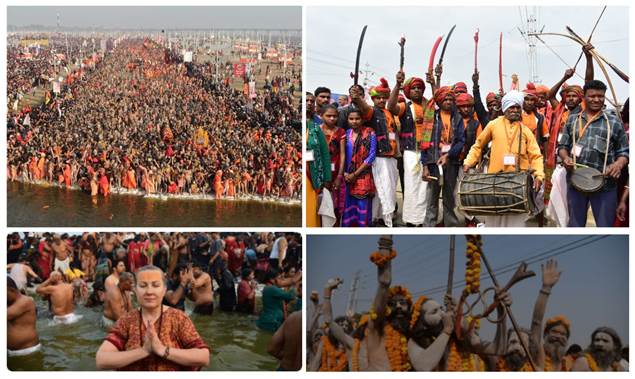The Maha Kumbh Mela 2025: Embracing Unity in the Sacred Waters of Prayagraj
In a world marked by the hustle of modernity, few events hold the power to bring millions together in pursuit of something greater than themselves. The Maha Kumbh Mela, a sacred pilgrimage that is celebrated four times over a course of 12 years, stands as a unique embodiment of such power. Kumbh Mela, the world’s largest peaceful gathering, draws millions of pilgrims who bathe in sacred rivers seeking to purify themselves from sins and attain spiritual liberation. As pilgrims prepare for their journey to Prayagraj from January 13 to February 26, they will not only engage in a series of spiritual rituals but also embark on an odyssey that transcends physical, cultural, and even spiritual boundaries.

The Maha Kumbh Mela is deeply embedded in Hindu mythology and represents one of the most significant gatherings of faith in the world. This sacred event rotates between four locations in India-Haridwar, Ujjain, Nashik, and Prayagraj- each situated by a holy river, from the Ganges to the Shipra, the Godavari, and the confluence of the Ganges, Yamuna, and the mythical Sarasvati in Prayagraj. The timing of each Kumbh Mela is determined by the astrological positions of the Sun, Moon, and Jupiter, believed to signal an auspicious period for spiritual cleansing and self-enlightenment. Rooted in the rich soils of Indian mythology and culture, the Maha Kumbh Mela is a profound representation of humanity’s timeless quest for inner peace, self-realization, and spiritual unity.
The Kumbh Mela is an event that intrinsically encapsulates the science of astronomy, astrology, spirituality, ritualistic traditions, and socio-cultural customs and practices, making it extremely rich in knowledge. This event is celebrated by a broad spectrum of pilgrims from the Hindu faith. Participants include ascetics, such as Sadhus and Naga Sadhus, who practice intense spiritual discipline, hermits who emerge from seclusion to join the Mela, seekers of spiritual wisdom, and everyday practitioners of Hinduism. This vast gathering embodies a unique convergence of faith, wisdom, and cultural heritage.
The Significance of Sacred Rituals
The Maha Kumbh Mela is a vibrant amalgamation of rituals, with the sacred bathing ceremony at its heart. At the confluence of the Ganges, Yamuna, and the mythical Sarasvati rivers, known as Triveni Sangam, millions of devotees gather to perform this deeply significant ritual. The act of immersing in these holy waters is believed to purify one of sins, liberate both individuals and their ancestors from the cycle of rebirth, and ultimately guide them towards Moksha, or spiritual liberation.

Alongside this primary ritual, pilgrims engage in worship along the riverbanks and attend spiritual discourses led by revered sadhus and saints. While devotees are encouraged to bathe at any time during the Prayagraj Maha Kumbh, certain dates, beginning with Paush Purnima, are especially auspicious. On these days, a spectacular procession of saints, their followers, and members of various Akharas (spiritual orders) takes place. They partake in the grand ritual known as Shahi Snan, also referred to as ‘Rajyogi Snan,’ marking the commencement of the Maha Kumbh Mela. This tradition holds that the faithful receive additional blessings from the accumulated virtues and spiritual energy of saints who have bathed before them, reinforcing the communal essence of this age-old celebration.
During the Kumbh Mela, a vibrant array of ceremonies unfolds. Key among them is the traditional procession of Akharas called ‘Peshwai’ on elephant backs, horses and chariots in a grand spectacle. Alongside this, numerous cultural events captivate millions of pilgrims who gather to witness and partake in this majestic festival.
Tracing the History: A Journey Through Time
The roots of the Kumbh Mela stretch back thousands of years, finding early references during the Maurya and Gupta periods (4th century BCE to 6th century CE). The initial gatherings, although not as large as the modern Kumbh Mela, drew pilgrims from across the Indian subcontinent. Over time, the Mela’s significance grew alongside Hinduism’s rise, with rulers like the Guptas further elevating its status as a revered religious congregation.
During the medieval period, the Kumbh Mela received patronage from various royal dynasties, including the Chola and Vijayanagar empires in the south, and the Delhi Sultanate and Mughals in the north. Even Mughal emperors such as Akbar are noted to have participated in the celebrations, illustrating a spirit of religious tolerance. Historical accounts reveal that in 1565, Akbar granted the Naga Sadhus the honor of leading the royal entry into the Mela, an act symbolizing unity across religious and cultural lines. In the colonial period, British administrators observed and documented the festival, intrigued by its massive scale and the diverse congregations it drew. Figures such as British colonial administrator James Prinsep chronicled the Kumbh Mela in the 19th century, detailing its ritualistic practices, the vast congregations, and the socio-religious dynamics at play. These accounts contributed valuable insights into the Kumbh’s evolution and its resilience through time.
Post-independence, the Maha Kumbh Mela gained even greater significance, symbolizing national unity and India’s rich cultural heritage. Recognized by UNESCO in 2017 as an intangible cultural heritage of humanity, the Kumbh Mela stands as a testament to the survival and evolution of ancient traditions in an era of modernization.
Celebration of Culture and Unity
The Maha Kumbh Mela is more than a gathering for spiritual cleansing; it is a vibrant cultural celebration. Traditional music, dance, art, and craftsmanship converge here, making the Mela a feast for the senses. Pilgrims experience not only a spiritual journey but also a deep dive into India’s diverse cultural landscape, united by a shared pursuit of inner peace and understanding.

International pilgrims and seekers of spirituality also gather, drawn by the Mela’s universal message of unity, tolerance, and transcendence. Amid the vibrant crowds and colorful displays, the Mela is a reminder that the longing for spiritual fulfillment is a common thread that binds humanity, rising above nationality, language, and beliefs.
Conclusion
The Maha Kumbh Mela in 2025 is not just a gathering; it is a journey towards the self. Beyond rituals and symbolic acts, it offers pilgrims an opportunity for inner reflection and a deeper connection with the divine. In a world often dominated by the demands of modern life, the Maha Kumbh Mela stands as a beacon of unity, purity, and enlightenment. This timeless pilgrimage serves as a powerful reminder that, despite humanity’s varied paths, we are united in essence—a shared journey towards peace, self-realization, and an enduring reverence for the sacred.
Adani Green Denies Allegations, Reaffirms Commitment to Governance and Compliance
The allegations made by the US Department of Justice and the US Securities and Exchange Co…


















